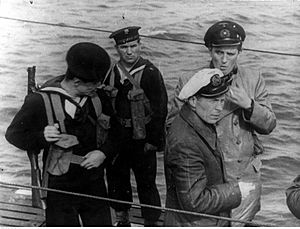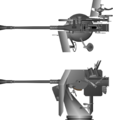German submarine U-249 facts for kids

U-249 after the surrender of Nazi Germany
|
|
Quick facts for kids History |
|
|---|---|
| Name | U-249 |
| Ordered | 5 June 1941 |
| Builder | Germaniawerft, Kiel |
| Yard number | 683 |
| Laid down | 23 January 1943 |
| Launched | 23 October 1943 |
| Commissioned | 20 November 1943 |
| Fate |
|
| General characteristics | |
| Class and type | Type VIIC submarine |
| Displacement |
|
| Length |
|
| Beam |
|
| Height | 9.60 m (31 ft 6 in) |
| Draught | 4.74 m (15 ft 7 in) |
| Installed power |
|
| Propulsion |
|
| Speed |
|
| Range | |
| Test depth |
|
| Complement | 4 officers, 40–56 enlisted |
| Armament |
|
| Service record | |
| Part of: |
|
| Commanders: |
|
| Operations: |
|
| Victories: | None |
The German submarine U-249 was a special kind of U-boat (a German submarine) used by Nazi Germany's navy, the Kriegsmarine, during World War II. It was built in Kiel, Germany. Work on the submarine started on 23 January 1943, and it was ready to sail on 23 October 1943. It officially joined the navy on 20 November 1943, led by a commander named Rolf Lindschau.
Even though it went on two patrols, U-249 did not sink any enemy ships. It surrendered on 10 May 1945, right after the war in Europe ended. Later, on 13 December 1945, it was sunk as part of something called Operation Deadlight.
Contents
Submarine Design and Features
U-249 was a Type VIIC submarine. These were a common type of German U-boat during World War II.
When U-249 was on the surface, it weighed about 769 tons. When it was underwater, it weighed more, around 871 tons. The submarine was about 67 meters (220 feet) long. Its main body, called the pressure hull, which kept the crew safe from the water pressure, was about 50.5 meters (166 feet) long.
The submarine was about 6.2 meters (20 feet) wide and 9.6 meters (31 feet) tall. It sat about 4.74 meters (15.5 feet) deep in the water.
How it Moved
U-249 used two different types of engines to move.
- On the surface, it had two powerful diesel engines. These engines gave it a top speed of about 17.7 knots (32.8 kilometers per hour or 20.4 miles per hour).
- Underwater, it used two electric motors. These allowed it to travel at a slower speed of about 7.6 knots (14.1 kilometers per hour or 8.7 miles per hour).
The submarine could travel a long way on the surface, about 8,500 nautical miles (15,742 kilometers) at a speed of 10 knots. Underwater, its range was much shorter, about 80 nautical miles (148 kilometers) at 4 knots.
How Deep it Could Go
U-249 was designed to operate safely at depths of up to 230 meters (750 feet). Its maximum depth before it would likely be crushed by the water pressure was between 250 and 295 meters (820 to 968 feet).
Crew and Weapons
The submarine usually had a crew of 4 officers and between 40 and 56 sailors.
It was armed with several weapons:
- Torpedoes: It had five torpedo tubes, which are like underwater cannons that fire torpedoes. Four were at the front and one was at the back. It carried 14 torpedoes. It could also carry 26 mines instead of torpedoes.
- Deck Gun: On its deck, it had one 8.8 cm (3.5 inch) naval gun with 220 rounds of ammunition.
- Anti-Aircraft Guns: To defend against airplanes, it had one 3.7 cm (1.5 inch) anti-aircraft gun and two twin 2 cm (0.79 inch) anti-aircraft guns.
Armament Details
Anti-Aircraft Guns
U-249 was equipped with special anti-aircraft guns to protect itself from enemy planes.
- It had a single 3.7 cm Flak M42U gun. This gun was placed on a special mount called the LM 43U. This mount was one of the last designs used on U-boats. Only a few other U-boats had this specific mount.
- It also had two 2 cm Flak C38 guns. These were in a twin mount called the M 43U Zwilling mount. This mount had a small folding shield to protect the gunners. It was located on the upper part of the submarine's deck, in an area known as the Wintergarten. Many other U-boats also used this type of mount.
Service History
After its training, U-249 joined the 5th U-boat Flotilla on 1 January 1945. This was a group of submarines ready for active duty.
First Patrol
Before its first official patrol, U-249 made a couple of short trips between Kiel in Germany and Kristiansand and Bergen in Norway. Its first real patrol began on 7 March 1945, when it left Bergen. It returned to the same port on 16 March. During another short trip, the submarine shot down a Mosquito airplane from the British No. 235 Squadron RAF. The pilot of the plane was captured.
Second Patrol and Surrender
U-249 left Bergen again on 3 April 1945 for its second patrol. This patrol ended on 10 May when the submarine arrived at Portland, UK. It was flying a black flag, which meant it was surrendering.
After its surrender, the British briefly used U-249 as a research ship, renaming it N 86. Later, it was moved to Loch Ryan in Scotland to be part of Operation Deadlight. This operation involved sinking many captured German U-boats. U-249 was sunk on 13 December 1945.
In May 2013, some interesting items from U-249 were shown on a TV show called Antiques Roadshow. These included the submarine's official visitors' book and Captain Kock's binoculars. A British officer who took command of the submarine after its surrender had kept them as war souvenirs. His son, who also became a submarine captain, showed them on the program, explaining that he had used the binoculars during his own career.



